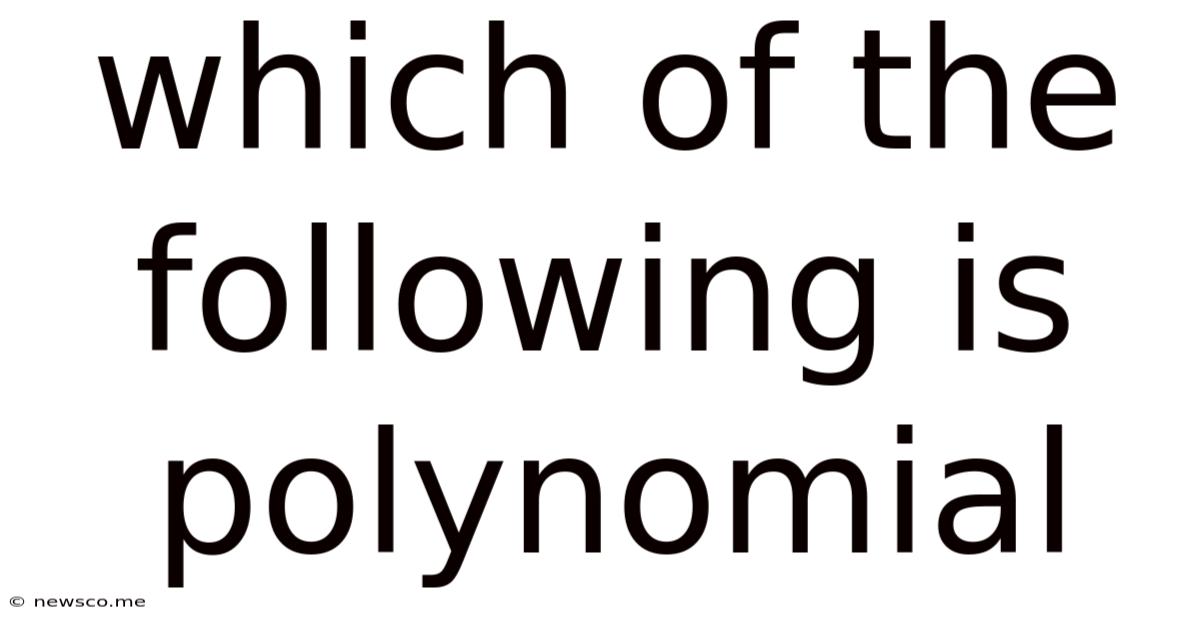Which Of The Following Is Polynomial
News Co
Apr 12, 2025 · 5 min read

Table of Contents
Which of the following is a polynomial? A Comprehensive Guide
Polynomials are fundamental algebraic expressions that form the bedrock of many mathematical concepts. Understanding what constitutes a polynomial and what doesn't is crucial for success in algebra, calculus, and beyond. This comprehensive guide will delve deep into the definition of a polynomial, explore various examples and non-examples, and equip you with the knowledge to confidently identify polynomials in any context.
Defining a Polynomial: The Essentials
A polynomial is an expression consisting of variables (often represented by x, y, z, etc.) and coefficients, combined using only addition, subtraction, and multiplication, with non-negative integer exponents on the variables. Crucially, polynomials do not include division by a variable.
Let's break down the key components:
- Variables: These are the unknowns represented by letters.
- Coefficients: These are the numerical values multiplying the variables.
- Exponents: These are the powers to which the variables are raised. They must be non-negative integers (0, 1, 2, 3, and so on).
- Allowed Operations: Only addition, subtraction, and multiplication are permitted. Division by a variable is strictly prohibited.
A polynomial can have one or more terms. Each term is a product of a coefficient and a variable raised to a non-negative integer power. The highest power of the variable in a polynomial is called its degree.
Examples of terms:
- 3x² (coefficient: 3, variable: x, exponent: 2)
- -5y (coefficient: -5, variable: y, exponent: 1)
- 7 (coefficient: 7, variable: none, exponent: 0 – remember, x⁰ = 1)
Identifying Polynomials: Examples and Non-Examples
Let's examine various expressions and determine whether they qualify as polynomials:
Examples of Polynomials:
- 3x² + 2x - 5: This is a polynomial of degree 2 (quadratic). It has three terms.
- x⁴ - 7x³ + 11x + 2: This is a polynomial of degree 4 (quartic).
- 5y⁵ + 2y² - 3y + 10: This is a polynomial of degree 5 (quintic).
- -2z: This is a polynomial of degree 1 (linear).
- 8: This is a polynomial of degree 0 (constant). It can be considered as 8x⁰.
Non-Examples of Polynomials (and why they fail the definition):
- 1/x: This expression involves division by a variable, violating the definition of a polynomial.
- x⁻²: A negative exponent implies division (x⁻² = 1/x²), which is not allowed.
- √x: This is equivalent to x^(1/2), where the exponent (1/2) is not an integer.
- x^(2/3): Similar to the previous example, the exponent is not an integer.
- 2ˣ: The variable is in the exponent, not the base. This is an exponential function, not a polynomial.
- (x+2)/(x-3): Division by a variable expression is forbidden.
- sin(x): Trigonometric functions are not polynomials.
- |x|: The absolute value function is not a polynomial.
- 2^x + 3x^2: This combines a polynomial term with an exponential term, resulting in a non-polynomial expression.
Common Mistakes in Polynomial Identification
Several common misconceptions can lead to misidentification of polynomials. Let's address some of them:
-
Mistaking rational functions for polynomials: Rational functions are ratios of polynomials (P(x)/Q(x)), where P(x) and Q(x) are polynomials. While the numerator might be a polynomial, the overall expression is not a polynomial if it contains a variable in the denominator.
-
Ignoring exponent restrictions: Remembering that only non-negative integer exponents are permitted is paramount. Fractional or negative exponents instantly disqualify an expression from being a polynomial.
-
Confusing polynomials with other functions: Many functions, such as exponential functions, logarithmic functions, trigonometric functions, and absolute value functions, are not polynomials. They possess characteristics distinct from polynomials.
The Significance of Polynomials in Mathematics and Beyond
Polynomials are not merely abstract algebraic objects. They hold immense significance in various areas of mathematics and its applications:
-
Algebra: Polynomials form the foundation of many algebraic concepts, including factoring, solving equations, and studying polynomial functions.
-
Calculus: Polynomials are essential in calculus for differentiation and integration, as their derivatives and integrals are relatively easy to compute. They are also used in Taylor and Maclaurin series approximations of more complex functions.
-
Computer Science: Polynomials are used in computer graphics, numerical analysis, and cryptography.
-
Physics and Engineering: Polynomials are used to model various physical phenomena, such as the trajectory of projectiles and the behavior of electrical circuits.
-
Economics and Finance: Polynomial models are used in forecasting and financial modeling.
Advanced Polynomial Concepts (Brief Overview)
For a deeper understanding, here are some advanced concepts related to polynomials:
-
Polynomial Long Division: A method for dividing polynomials, similar to long division with numbers.
-
Synthetic Division: A simplified method for dividing polynomials by linear factors.
-
Remainder Theorem: Relates the remainder of a polynomial division to the value of the polynomial at a specific point.
-
Factor Theorem: States that if a polynomial P(x) has a root (or zero) at x = a, then (x - a) is a factor of P(x).
-
Fundamental Theorem of Algebra: This theorem states that a polynomial of degree n has exactly n complex roots (counting multiplicities).
Conclusion: Mastering Polynomial Identification
Identifying polynomials correctly is a fundamental skill in mathematics. By thoroughly understanding the definition, carefully examining the components of expressions, and being aware of common pitfalls, you can confidently distinguish polynomials from other algebraic expressions. This mastery is essential for progress in various mathematical fields and their applications. Remember to always check for non-negative integer exponents and the absence of division by variables. Through consistent practice and attention to detail, you will become proficient in identifying polynomials and harnessing their power in your mathematical endeavors.
Latest Posts
Related Post
Thank you for visiting our website which covers about Which Of The Following Is Polynomial . We hope the information provided has been useful to you. Feel free to contact us if you have any questions or need further assistance. See you next time and don't miss to bookmark.